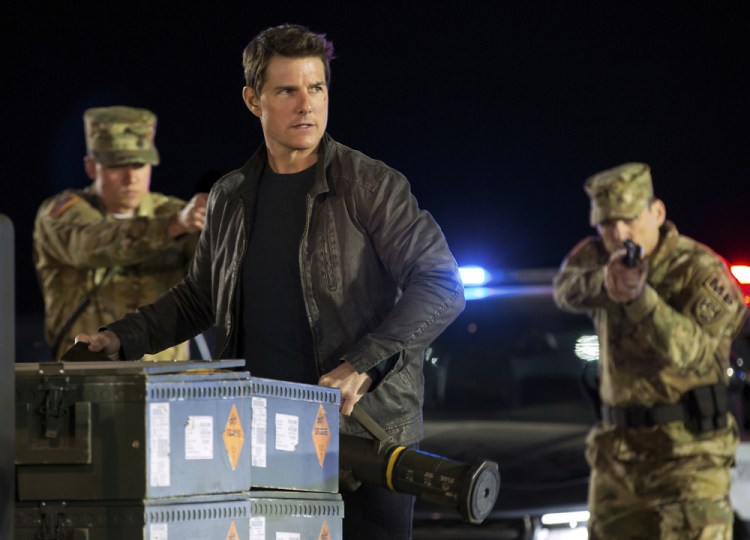Jack Reacher, invincible fighting force and righter of wrongs, is 6-foot-5; Tom Cruise, movie star, is 5-foot-7. Such is the magic of movies: “Jack Reacher: Never Go Back” opened Friday with Cruise playing the former Army major for the second time, and one of the more convincing aspects of the film is its physicality. It’s as if the fight scenes were produced in Hong Kong.
“We talked a lot about it, what we wanted to do,” said director Edward Zwick, who also made “The Last Samurai” (2003) with Cruise, “and we came to the conclusion that maybe audiences were suffering a little bit from superhero fatigue – that they were tired of watching characters getting knocked through the earth and bouncing back. We decided we didn’t want to deny the laws of physics, or use CGI in any of it.”
“That’s very much Cruise,” said author Lee Child, whose 21st Reacher novel (“Night School”) will be published next month. “I think he loves to do his own stunts, and I think the others absolutely joined in with that.”
The others include Cobie Smulders, who plays Maj. Susan Turner, a career military police officer with whom Reacher has developed something of a phone romance. He’s about to actually meet her when he discovers Turner has been arrested, accused of treason and embroiled in a wide-reaching conspiracy involving Mideast arms shipments. It’s a scheme that ensnares Reacher, too – he’s accused of an old murder and a new murder and is facing a paternity suit from a woman he can’t remember. The offspring of their alleged liaison, Samantha Dayton (Danika Yarosh), becomes part of Reacher’s fugitive team, which is trying to outrun a seemingly unstoppable mercenary (Patrick Heusinger) assigned to kill them.
The fact that Heusinger’s character – referred to only as The Hunter – is a former military contractor and his bosses are part of a secret government operation is a hot-button plot point. On one hand, it provides a way not to “replicate the same Chechen terrorist again,” Zwick said. But it’s also valid as a reality-based political angle, albeit in an action movie. “Inevitably every movie is reductionist,” he said, “and the villains become shorthand. But it’s very legitimate.”
The author agreed. “Whatever your politics,” Child said, “you can still say certain functions should be done by the government, and if you parcel them out to people with a profit motive you’re not going to get the same result – maybe not a terrible criminal result, but it wouldn’t be the same. And it does introduce the possibility of corruption and skimming and all kinds of things. Which I’m sure are going on. And if you ask people, I’m sure they’d say it’s going on.”
They’re certainly going on in “Never Go Back,” which is based on the 18th Reacher book, (The 2012 movie “Jack Reacher” was based on the ninth book, titled “One Shot”). Zwick admits to “a certain promiscuity” in his work for TV and the big screen – he and his “Never Go Back” co-writer Marshall Herskovitz created the ’80s TV series “thirtysomething” and Zwick has produced many celebrated films, including “Shakespeare in Love” (1998) and “Traffic” (2000). But “Never Go Back” gave him pause.
“When Tom called, I said, ‘A franchise? A sequel?’ A genre?'” Zwick remembered. “He said, ‘Read the book,’ and I did, and I saw the opportunity to do something with a little more ‘me’ in it, in addition to expanding on the elements of the genre.”
He also didn’t have the author breathing down his neck. “You have to be so brutal about stripping a book down and putting it back together,” Child said of movie adaptations in general. “I think that’s very difficult for a book writer, because from our point of view, obviously, every word is genius. Otherwise, why is it there? How can you choose what to get rid of?”
Child laughed. “So I told Ed Zwick from the very beginning that, ‘This is your thing,’ and I could sort of see him relax. He wouldn’t have that voice in the back of his mind, ‘What is Lee going to think?'”
He might think he’s got a hit. Initially, the first Jack Reacher movie, directed by Christopher McQuarrie, was lackluster at the box office, but then made hundreds of millions overseas – so perhaps that Hong Kong comparison has some traction.
Zwick admitted that there were some “economic realities” to making “Never Go Back” – the entire film was shot in just one of the novel’s locales, New Orleans, though the viewer will be convinced the characters have also been in Washington, D.C. – but he was more interested in the “artistic realities.”
“As someone who’s been privileged enough to have done projects in many genres and media, it’s nice do a project with complexity,” he said. “And that’s something that is increasingly rare.”
Copy the Story LinkSend questions/comments to the editors.



Success. Please wait for the page to reload. If the page does not reload within 5 seconds, please refresh the page.
Enter your email and password to access comments.
Hi, to comment on stories you must . This profile is in addition to your subscription and website login.
Already have a commenting profile? .
Invalid username/password.
Please check your email to confirm and complete your registration.
Only subscribers are eligible to post comments. Please subscribe or login first for digital access. Here’s why.
Use the form below to reset your password. When you've submitted your account email, we will send an email with a reset code.